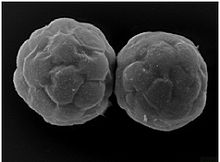Selenoproteïnes
Sel15, SelL, Fep15
Adell A, Agustín JM, Andrés C, Bartrolí M, Brasó M
Resum
L'objectiu d'aquest treball és buscar i comprovar si en els genomes de determinats protists seqüeniciats recentment s'hi troben homòlegs de determinades selenoproteïnes descrites en altres organismes. Concretament les selenoproteïens SelL, Sel15 i Fep15.
Les selenoproteïnes són un conjunt de proteïnes que posseeixen selenocisteïna (Sec), un anàleg de la cisteïna que conté seleni enlloc de sofre. Apareixen de manera molt àmplia al llarg de l’evolució i les podem trobar en els tres dominis de la vida: eucariota, bacterià i archaea. La selenocisteïna és codificada pel codó UGA, normalment codó de finalització, pel que és necessaria una estructura a l'extrem 3' no traduït del mRNA anomenada element SECIS.
Per a realitzar aquesta cerca hem utilitzat diferents eines informàtiques: tBLASTn, Exonerate, Genewise, Tcoffee, a més de la cerca d'elements SECIS i proteïnes necessàries per a la síntesi de selenoproteïnes.
Els resultats obtinguts descriuen presència de la Sel15 en Dictyostelium discoideum i Dictyostelium fasciculatum. En el cas de la SelL, no s'ha trobat la presència d'aquesta en cap protist, tot i haver trobat el domini Prx-like2 en el genoma de Dictyostelium discoideum. Pel que fa a la Fep15, aquesta no és present en cap dels genomes analitzats.
Abstract
Having 14 different genomes recently sequenced, this project's aim is to check if any of them contain selenoprotein homologies, which have been previously described in other organisms. These selenoproteins include: SelL, Sel15 and Fep15.
Selenoproteins are a group of proteins that include a selenocistein (Sec) on their sequence. Selenocisteins are cysteine analogous that contain selenium instead of sulphure on their structure. They have been appearing since the beginning of the evolution, which means that nowadays we can find them in the three main life regions: eukaryote, prokaryote and archaea. Selenocysteins are encoded by the UGA codon, which uses to be a stop codon. Sometimes, when there is a SECIS element on the 3' region of the mRNA, UGA codons encode for a selenocystein instead of a stop codon.
We used different informatic programs such as tBLASTn, Exonerate, Genewise or Tcoffee, in order to find selenoproteins in the protist genomes. We also looked for SECIS elements and some proteins required for the Selenoprotein synthesis.
Final results confirm the Sel15 presence in two different organisms: Dictyostelium discoideum and Dictyostelium fasciculatum. SelL does not exist in any of the analyzed genomes, even though we found the Prx-like2 domain in the Dictyostelium discoideum. Finally, Fep15 was not found in any of our genomes.














